| Ref |
Subject |
Location |
Description |
Size |
Price |
Image |
| P2956 | Portraits | | Blanch Somerset, Broness Arundell of Wardour, c1827. Engraved by T A Dean. Steel engraving. Lady Blanche Arundell (c1584-1649) was the daughter of Edward Somerset, 4th Earl of Worcester and Lady Elizabeth Hastings. In 1607 she married Thomas Arundell, 2nd Baron Arundell of Wardour, In 1643, during the absence of her husband she defended Wardour Castle for nine days with only herself, her children, a few maid-servants, and 25 men against the Parliamentary forces of 1300 hundred men and artillery. She surrendered on honourable term which were not honoured, with the castle being sacked, and she was imprisoned in Dorchester. | h 125mm x w 101mm | £10 | 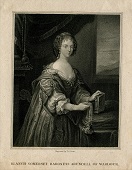 |
| P2971 | Portraits | | C M von Weber, c1845. Engraved by A H Payned and published by Brain & Payne. Steel engraving. Carl Maria Friedrich Ernst von Weber (1786-1826) was a German composer, conductor, pianist, guitarist and critic. He was one of the first significant composers of the Romantic school. | h 168mm x w 142mm | £10 | 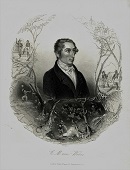 |
| P2910 | Portraits | | Catherine, The Fair Maid of Perth, 1851. Drawn by W Drummond and engraved by W H Egleton. Steel engraving. The Fair Maid of Perth is a novel by Sir Walter Scott. Inspired by the story of the Battle of the North Inch, it is set in Perth and other parts of Scotland around 1400. | h 107mm x w 132mm | £8 | 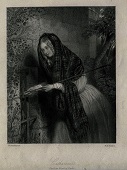 |
| P3009 | Portraits | | Clare, 1833. Engraved by E Finden for the "Life and Works of Lord Byron". Steel engraving. Lord Clare was a friend of Byron at Harrow School and the subject of his poem 'To the Earl of Clare'. They met briefly for the last time in 1822 in Livorno. | h 100mm x w 98mm | £8 | 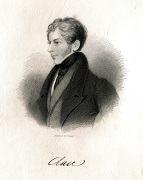 |
| P2961 | Portraits | | Cromwell, from a Beautiful Picture by Holbein In the Possession of Sir William Burrell, Barronet, 1792. Drawn by S Harding and engraved by Schiavonelli. Published by E Harding. Stipple engraving. Thomas Cromwell, 1st Earl of Essex,?(1485-1540), was an English lawyer and statesman who served as chief minister to King Henry VIII from 1532 to 1540. He was executed for treason and heresy in 1540. | h 128mmx w 108mm | £12 | 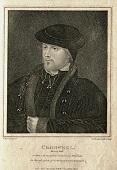 |
| P2953 | Portraits | | Dom Louis D'Harro, c1700s. Engraved by Theodor van Merlen. Copper engraving. | h 140mm x w 115mm | £15 | 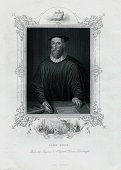 |
| P2920 | Portraits | | Dowager Marchioness of Donegal, 1808. Drwn by William Marshall Graig and engraved by K Mackenzie. Stipple engraving. Barbara Chicester, Marchioness of Donegall, (1768-1829), n?e Godfrey, was the 3rd wife of Arthur Chicester, 1st Marquess of Donegal. | h 150mm x w 95mm | £8 | 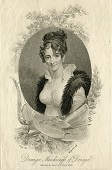 |
| P2942 | Portraits | | Dryden, c1775. Drawn by G Kneller and engraved by W Sharp. Published by G Kearsly. Copper engraving. A poet, dramatist and literary critic, John Dryden (1631-1700) was appointed Poet Laureate by Charles II in 1668. He wrote over twenty plays and numerous poems. In 1686 he converted to Roman Catholicism, and in 1688 was deprived of the laureateship. He devoted the rest of his life largely to translations, notably a verse translation of the works of Virgil. | h 150mm x w 111mm | £12 | 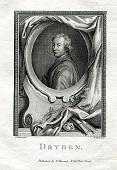 |
| P2936 | Portraits | | Duke of Wellington, 1852. Drawn by Lewis and engraved by J B Hunt. Published by Rogerson & Tuxford. Steel engraving. Field Marshal Arthur Wellesley, 1st Duke of Wellington (1769-1852), was one of the leading military and political figures of 19th century Britain, famous for his defeat of Napoleon at the Battle of Waterloo in 1815. After his active military career, Wellesley returned to politics and was twice prime minister of the Tory party. | h 190mm x w 130mm | SOLD | 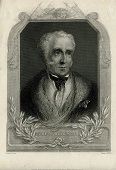 |
| P2937 | Portraits | | Duke of Wellington, c1845. Drawn by L Hicks and engraved by A H Payne. Steel engraving. Field Marshal Arthur Wellesley, 1st Duke of Wellington (1769?1852), was one of the leading military and political figures of 19th-century Britain, famous for his defeat of Napoleon at the Battle of Waterloo in 1815. After his active military career, Wellesley returned to politics and was twice prime minister as part of the Tory party. | h 220mm x w 180mm | £18 | 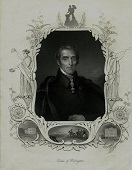 |
| P2935 | Portraits | | Duke of Wellington, c1845. Published by Tallis. Steel engraving. Field Marshal Arthur Wellesley, 1st Duke of Wellington (1769-1852), was one of the leading military and political figures of 19th-century Britain, famous for his defeat of Napoleon at the Battle of Waterloo in 1815. After his active military career, Wellesley returned to politics and was twice prime minister as part of the Tory party | h 140mm x w 112mm | £10 | 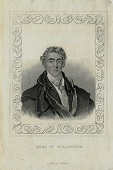 |
| P2928 | Portraits | | Elizabeth Fry, 1845. Drawn by C R Leslie and engraved by J Cochran. Steel engraving. Elizabeth Gurney was born in Norwich into a prominent Quaker family. Her father was a partner in Gurney's Bank. Her mother was a member of the Barclay family who were among the founders of Barclays Bank. She is best known for her humanitarian work in Prisons. In 2001, Fry appeared on the reverse of ?5 notes issued by the Bank of England. | h 118mm x w 90mm | £10 | 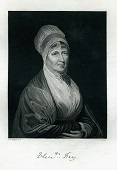 |
| P2934 | Portraits | | Field Marshall The Duke of Wellington, c1845. Engraved by Lightfoot and published by Virtue & Co. Steel engraving. Field Marshal Arthur Wellesley, 1st Duke of Wellington (1769-1852), was one of the leading military and political figures of 19th-century Britain, famous for his defeat of Napoleon at the Battle of Waterloo in 1815. After his active military career, Wellesley returned to politics and was twice prime minister as part of the Tory party. | h 127mm x w 98mm | £10 | 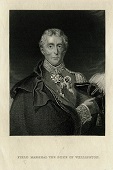 |
| P2941 | Portraits | | Francis Grose,Esq. FSA, 1787. Drawn by N Dance and engraved by F Bartolozzi. Published by S Hooper. Francis Grose (1731-1791) was an antiquary, draughtsman, and lexicographer,best known for ?The Antiquities of England and Wales? and ?The Antiquities of Scotland?. His dictionaries included ?A Classical Dictionary of the Vulgar Tongue? and ?A Provincial Glossary, with a Collection of Local Proverbs, and Popular Superstitions?. In 1789 he became a friend of Robert Burns. | h 210mm x w 175mm | £20 | 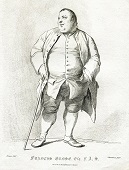 |
| P2940 | Portraits | | Goethe, c1845. Drawn by S Carse and engraved by A H Payne and published by Brain & Payne. Steel engraving. Johann Wolfgang von Goethe (1749-1832) was a German writer and statesman. His work includes epic and lyric poetry; plays; memoirs; an autobiography; literary and aesthetic criticism; treatises on botany, anatomy, and colour; and four novels. | h 158mm x w143mm | £12 | 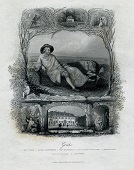 |
| P2967 | Portraits | | Henry VIII, c1850. Based on a portrait by Holbein. Steel engraving. Henry VIII (1491-1547) was King of England from 1509 until his death. He was Lord, and later assumed the Kingship, of Ireland, and continued the claim by English monarchs to the Kingdom of France. Besides his six marriages, he is known for his establishment of the Church of England and the Dissolution of the Monasteries. | h 198mm x w 122mm | £12 | 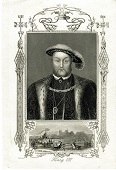 |
| P3013 | Portraits | | Ianthe (from the original picture at therequest of Lord Byron), 1832. Painted by R Westall and engraved by W Finden for the "Life and Works of Lord Byron". Steel engraving. Lady Charlotte Mary Bacon, n?e Harley (1801-1880), was the daughter of Edward Harley, 5th Earl of Oxford and Earl Mortimer. Byron who had been a lover of her mother Jane Elizabeth Scott was prompted by her beauty to dedicate two cantos of Childe Harold's Pilgrimage to her, under the name "Ianthe". She was also painted as Hebe by Richard Westall. In 1823 she married Captain Anthony Bacon in 1823. Charlotte Waters, Northern Territory in Australia is named after her. | h 170mm x w 104mm | £8 | 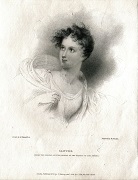 |
| P2950 | Portraits | | Jean Baptiste van Heil, c1650. Copper engraving. Jan Baptist van Heil was a Flemish Baroque painter. | h 140mm x w 107mm | £20 | 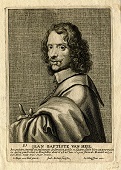 |
| P2929 | Portraits | | Joanna Southcott, 1814. Published by John Bull. Stipple engraving. Joanna Southcott (or Southcote) (1750?1814), was a self-described religious prophetess. Born in Taleford, and raised in Gittisham, Devon,she was for a long time a servant in Exeter. She was originally of the Church of England, but about 1792, thinking that she possessed supernatural gifts, she wrote and dictated prophecies in rhyme, and announced herself as the Woman of the Apocalypse spoken of in Revelations. | h 110mm x w 89mm | £10 | 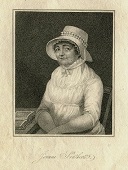 |
| P2938 | Portraits | | John Knox. From the Original at Holyrood Palace, Edinburgh, c1850. Engraved by G Stodart andpublished by Virtue & Co. Steel engraving. Knox (c1513?1572) was a Scottish clergyman who led the Protestant Reformation and is considered the founder of the Presbyterian denomination in Scotland. | h 195mm x w 137mm | SOLD |  |
| P2930 | Portraits | | John Sebastian Bach with Views of The St Thomas's School, Bach's Monument, St Thomas's Church & Observatory at Leipzig, 1845. Drawn by H Bibby and engraved by A H Payne for Payne's "Universum ...". Steel engraving. Johann Sebastian Bach 1685-1750)was a German composer and musician of the Baroque period. His compositions include the Brandenburg Concertos, the Goldberg Variations, the Mass in B minor, two Passions, and over 300 cantatas. He is now generally regarded as one of the greatest composers of all time. | h 150mm x w 111mm | £12 | 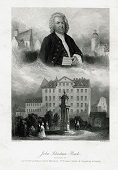 |
| P2931 | Portraits | | L. v. Beethoven, 1845. Drawn by Storck and engraved by A H Payne for Payne's "Universum ...". Steel engraving. Ludwig van Beethoven (1770?1827) was a German composer. He is one of the most famous of all composers. His most famous compositions include 9 symphonies, 5 piano concertos, 1 violin concerto, 32 piano sonatas, 16 string quartets, his great Mass the Missa solemnis and the opera, Fidelio. | h 175mm x w 150mm | £12 | 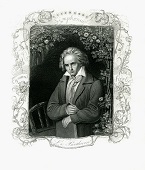 |
| P2949 | Portraits | | Lord Byron, c1845. Published by Tallis. Steel engraving. Lord Byron, (1788-1824) was an English poet and a leading figure in the Romantic movement. Among his best-known works are the narrative poems Don Juan and Childe Harold's Pilgrimage. One of the greatest British poets, he travelled in Europe, especially Italy where he lived for seven years. Later, he joined the Greek War of Independence against the Ottoman Empire. He was notorious for his debts, numerous affairs and self-imposed exile. | h 140mm x w 112mm | £10 | 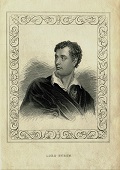 |
| P2914 | Portraits | | Louis XVII King of France and Navarre. Born at Versailles the 27th March 1785. Dedicated to His Royal Highness The Prince Regent, 1814. Drawn and engraved by N Heideloff, engraver to His Serence Highness the Duke of Wurtenberg. Stipple engraving | h 150mm x w 107mm | £12 | 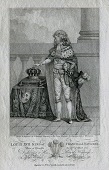 |
| P2924 | Portraits | | Margaret Dutchess of Burgundy, Sister of Edward4th King of England. An ancient picture in the possession of T Kerrich, M.A. Principal Linrarian to the University of Cambridge, 1804. Drawn by Thomas Kerrich and engraved by Johann Gottlieb Facius. Published by William Richardson. Stipple engraving. Trimmed on right hand side with samall loss to border. Margaret of York (1446?1503) was the Duchess of Burgundy and the third wife of Charles the Bold. She acted as a protector of the Duchy after his death. She was a daughter of Richard Plantagenet, 3rd Duke of York, and the sister of two Edward IV and Richard III. Born at Fotheringhay Castle, Northamptonshire she died at Mechelen in the Low Countries. | h 178mm x w 135mm | £12 | 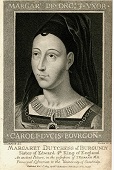 |
| P2926 | Portraits | | Marie de Duchesse de Chevreuse. From a acarsce Print in the Collection of R Bull Esq. 1801. Published by Edward Harding. Copper engraving. Marie de Rohan (1600?1679) was a French aristocrat, famed for being the centre of many of the intrigues of the first half of the 17th century in France. She is often known simply as Madame de Chevreuse. | h 120mm x w 98mm | £10 | 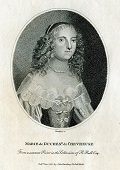 |
| P2958 | Portraits | | Marlborough, c1860. Drawn by Sir G Kneller and engraved by J Posselwhite. Published by Virtue & Co. Steel engraving. General John Churchill, 1st Duke of Marlborough, (1650-1722) was an English soldier and statesman whose career spanned the reigns of five monarchs. | h 135mm x w 112mm | £10 | 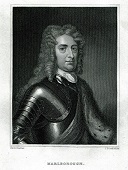 |
| P2917 | Portraits | | Mary Burwell, wife of Robert Walpole, from an original at Wolterton, 1802. Drawn by W Gardiner and engraved by E Harding. Stipple engraving. Mary Burwell (1654-1711) married Colonel Robert Walpole and was the mother of Sir Robert Walpole (1676-1745), Prime Minister of Great Britain. | h 113mm x w 88mm | £18 |  |
| P2957 | Portraits | | Mary Stuart, c1850 . Drawn by Frino and engraved by T W Hunt for the "History ofEngland". Steel engraving. Mary, Queen of Scots (1542-1587), also known as Mary Stuart or Mary I of Scotland, was Queen of Scotland from 1542 to 1567 and Queen consort of France from 1559 to 1560. In 1565 she married her cousin Lord Darnley who was later murdered, possibly by James Hepburn, but after he was acquitted he married Mary. Following an uprising, Mary abdicated in favour of her son James. After trying to regain the throne, she sought the protection of her cousin, Queen Elizabeth I. Mary had claimed Elizabeth's throne as her own and was considered the legitimate sovereign of England by many English Catholics. Eventually she was found guilty of plotting to assassinate Elizabeth, and was executed. | h 122mm x w 96mm | £8 | 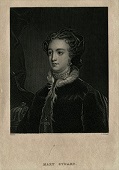 |
| P2919 | Portraits | | Miss Carew, engraved from an Original by Hayter, 1817. Published by John Bell 1817. Stipple engraving. Miss CAreew, born 1799 was a singer at the English Opera House and Drury Lane. | h 132mm x w 115mm | £10 | 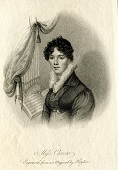 |
| P2908 | Portraits | | Miss Chaworth (from an original at the age of 15), c1850. Drawn by F Stone and engraved by W Finden. Stipple engraving. Mary Chaworth was a distant cousin, neighbour and childhood friend of Lord Byron. | h 112mm x w 98mm | £8 | 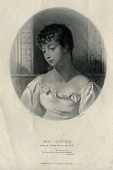 |
| P2922 | Portraits | | Miss E W Blanchard from an Original Drawing by Rose Emma Drummond, 1818. Published by John Bell. Stipple engraving. Miss Blanchard was an actress. | h 145mm x w 135mm | £10 | 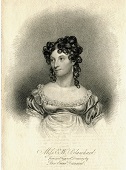 |
| P2913 | Portraits | | Miss Price. Engraved by Cooper from an original painting by Sir Peter Lely. Published by John Bell, 1819. Stipple engraving. | h 115mm x w 101mm | £8 | 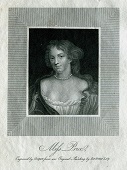 |
| P2918 | Portraits | | Miss Stanley of Drury Lane Theatre, 1814. Drawn by O P Stephanoff and engraved by I Alais. Stipple engraving. | h 130mm x w 98mm | £8 | 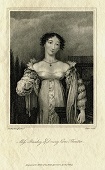 |
| P2909 | Portraits | | Mrs Bruce of Clackmannan from the original in the possesion of R Scott Moncreieff Esquire, 1846. Drawn by G Chalmers and engraved by H Robinson. Steel engraving, Frances Anna Wallace Dunlop of Dunlop (1730-1815) was a widow and the mother of thirteen children when she met Robert Burns. Whilst convalescing after an illness brought on by the death of her husband she had a Kilmarnock edition of Burns poems given to her and immediately invited Burns to meet her. | h 120mm x w 100mm | £10 | 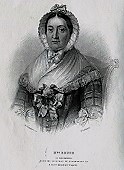 |
| P2939 | Portraits | | Mrs Dunlop of Dunlop, fromthe original in possession of the family, 1846. Engraved by H Robinson and published by Blackie & Son in "The Land of Burns". Steel engraving. Frances Anne Walker Dunlop (1730?1815), of Dunlop, was descended from a brother of William Wallace. She met Robert Burns in 1786. On reading the Cottar's Saturday Night whilst recovering from an illness, she enjoyed it so much that she sent to Burns's home, for half a dozen copies, and invited Burns to call at Dunlop House. They became regular correspondents. | h 107mm x w 125mm | £12 | 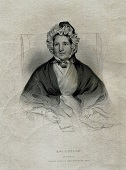 |
| P2915 | Portraits | | Mrs Elizabeth Burnet, 1815. Engraved by Hopwood and published by Ogles, Duncan and Cochran. Stipple engraving. | h 80mm x w 67mm | £8 | 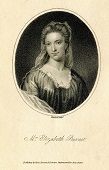 |
| P2921 | Portraits | | Mrs Fitzherbert, 1810. Drawn by Johyn Russell and engraved by Robert Cooper. Sipple engraving. Trimmedclose at top but not affeting image. Twice widowed, Maria Fitzherbert (1756-1837) married George, Prince of Wales, in secret in 1795, by whom she reputedly had two children. | h 130mm x w 95mm | £8 | 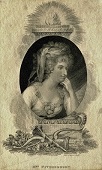 |
| P2912 | Portraits | | Mrs Jordan. From an Original Picture in the possession of the Duke of Clarence. In the Character of Euphrosyne in Comus. Published in 1814 by John Bell. Engraving. Dorothea Jordan (1761?1816) was an Anglo-Irish actress, courtesan, and the mistress and companion of the future King William IV , for 20 years while he was Duke of Clarence. They had ten illegitimate children, all of whom took the surname FitzClarence. | h 152mm x w 122mm | £10 | 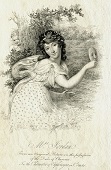 |
| P2923 | Portraits | | Mrs Yates. Engraved by I Alais from an Original Drawing by Rose Emma Drummond, 1818. Published by John Bull. Stipple engraving. Elizabeth Yates (1799?1860) was an English actress who worked under the names Miss Brunton, Elizabeth Brunton, Elizabeth Yates and Mrs Yates. She made her London debut at Covent Garden in 1817. | h 103mm x w 79mm | £8 | 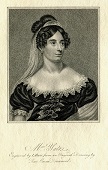 |
| P2948 | Portraits | | Oliver Cromwell, c1770. Engraved by T Cook and published by G Kearsly. Copper engraving. Oliver Cromwell (1599-1658) was an English military and political leader and later Lord Protector of the Commonwealth of England, Scotland and Ireland. | h 152mm x w 112mm | £18 | 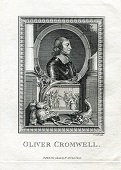 |
| P2969 | Portraits | | Oliver Cromwell, from the original of Walker in the colleciton of the Right Honble The Earl Spencer, c1846. Engraved by H Robinson and published by John Tallis & Company. Steel engraving. Oliver Cromwell (1599-1658) was an English military and political leader and later Lord Protector of the Commonwealth of England, Scotland and Ireland. | h 180mm x w 160mm | SOLD | 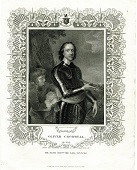 |
| P2970 | Portraits | | Philippus III dei Gratia Hispaniarum et Indiarum rex, c1615. Engraved by N de Clerck. Copper engraving laid on paper. Philip III of Spain (1578-1621) was King of Spain. A member of the House of Habsburg, he was the son of Philip II of Spain and his fourth wife and niece Anna, the daughter of the Emperor Maximilian II and Maria of Spain. Philip III married his cousin Margaret of Austria, sister of Ferdinand II, Holy Roman Emperor. | h 192mm x w 120mm | £25 | 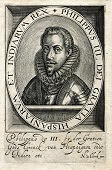 |
| P2906 | Portraits | | Princess Mary, Born April 25 1776. Published in "The New Lady's Magazine, Or, Polite and Entertaining Companion for the Fair Sex", c1790. Copper engraving. Trimmed to image. Princess Mary, Duchess of Gloucester (1776-1857) was the fourth daughter of George III and wife of William Frederick, 2nd Duke of Gloucester. | h 163mm x w 111mm | £10 | 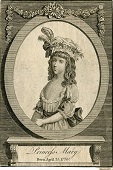 |
| P2907 | Portraits | | Queen Elizabeth, 1749. Published by John Hinton for the Universal Magazine. Copper engraving. | h 167mm x w 100mm | £12 | 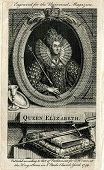 |
| P2905 | Portraits | | Queen Elizabeth. From a Curious Limning in a Manuscript in the BodleianLibrary, Oxford. 1807. Drawn by S Harding and engraved by E Harding. Copper engraving. | h 133mm x w 92mm | £12 | 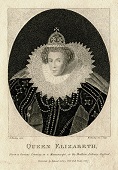 |
| P2951 | Portraits | | Robert Burns, c1846. Drawn by A Nasmyth and engraved by H Robinson. Steel engraving. | h 140mm x w 112mm | SOLD | 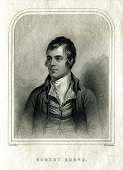 |
| P2932 | Portraits | | Rogero Bruxellensi Pictori, c1610. Engraved by Th Galle, Copper engraving. Trimmed to border and laid on paper. | h 210mm x w 118mm | £25 |  |
| P2959 | Portraits | | Samuel Mathews. The Dulwich Hermit, 1803. Drawn by G Arnold and engraved by J Greig. Published by R S Kirby in the "Wonderful Museum". Copper engraving with hand colouring. Samuel Matthews, a jobbing gardener became famous from living in a cave he constructed in Dulwich Woods. His murder in 1802 was reported in ?The Times?. | h 170mm x w 110mm | £15 | 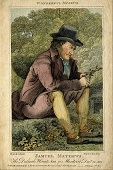 |
| P2947 | Portraits | | Schiller, c1845. Drawn by S CArse and engraved by A H Payned and published by Brain & Payne. Steel engraving. Johann Christoph Friedrich von Schiller (1759-1805) was a German poet, philosopher, historian, and playwright. During the last seventeen years of his life he became friends with Johann Wolfgang von Goethe. | h 153mm x w 120mm | £10 | 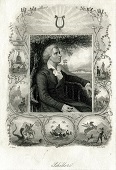 |
| P2943 | Portraits | | Sir Joshua Reynolds, Knight, 1811. Engraved by William Bond for "the Fine Arts of the English School". Copper engraving. Sir Joshua Reynolds RA FRS FRSA (1723-1792) was an influential English painter, specialising in portraits. He was a founder and first president of the Royal Academy of Arts, and was knighted by George III in 1769.
| h 194mm x w 164mm | £18 | 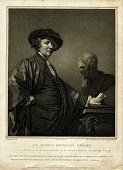 |
| P2944 | Portraits | | Sir Joshua Reynolds, c1845. Engraved for "Townsends' Alphabetical Chronology". Steel engraving. Sir Joshua Reynolds RA FRS FRSA (1723-1792) was an influential English painter, specialising in portraits. He was a founder and first president of the Royal Academy of Arts, and was knighted by George III in 1769. | h 140mm x w 111mm | £8 | 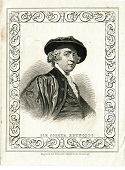 |
| P2963 | Portraits | | Sir Robert Peel, c1846. Painted by Sir Thomas Lawrence and engraved by J Cochran. Published by the London Printing and Publishing Company Ltd. Steel engraving. Sir Robert Peel, 2nd Baronet (1788-1850) was a British statesman who twice Prime Minister. He is regarded as the father of the modern British police and as one of the founders of the modern Conservative Party. | h 125mm x w 102mm | £10 | 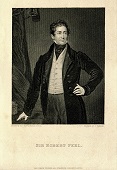 |
| P2945 | Portraits | | Sir Walter Raleigh, c1770. Engraved by W Sharpand published by G Kears. Copper engraving. Sir Walter Raleigh (c1554-1618) was an English writer, poet, soldier, politician, courtier, spy, and explorer, known for popularising tobacco in England. He was instrumental in the English colonisation of North America and led expeditions searching for El Dorado in South America, publishing his experiences in a book. Having attacked a Spanish outpost, he was later arrested and executed. | h 150mm x w 110mm | £15 | 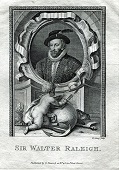 |
| P2954 | Portraits | | Sr Anthony Brown, 1811. Engraved by R Cromek and published by Edward Harding. Copper engraving. | h 163mm x w 158mm | £25 | 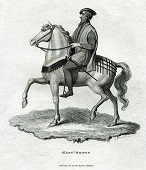 |
| P2946 | Portraits | | Sr John Hawkins, c1752. Engraved for the Universal Magazine. Copper engraving. Admiral Sir John Hawkins (1532-1595) was an English naval commander, merchant, navigator, shipbuilder, privateer and slave trader. One of the foremost seamen of 16th-century England, he was the chief architect of the Elizabethan navy. In the battle with the Spanish Armada he served as a vice admiral. | h 155mm x w 90mm | £10 | 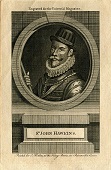 |
| P2955 | Portraits | | Sr Thomas Moore, c1790. Engraved by T Cook. Copper engraving.Sir Thomas More (1478-1535), venerated by Catholics as Saint Thomas More, was a lawyer, social philosopher, author, statesman and noted Renaissance humanist. He was a councillor to Henry VIII, and Lord High Chancellor of England from 1529 to 1532. More opposed the Protestant Reformation. In 1516 he wrote Utopia about the political system of an imaginary ideal island nation. More refused to acknowledge Henry as Supreme Head of the Church of England and the annulment of his marriage. He was convicted of treason and beheaded. More was canonised in 1935. | h 155mm x w 118mm | £15 | 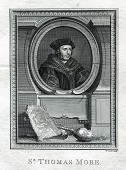 |
| P3010 | Portraits | | T Campbell, 1834. Paintd by Sir Thomas Lawrence and engraved by E Finden. Steel engraving. Thomas Campbell (1777-1844) was a Scottish poet. A co-founder of the Literary Association of the Friends of Poland, he was also one of the initiators of a plan to found what became University College London. He was elected Lord Rector of Glasgow University (1826?1829) in competition against Sir Walter Scott. He was buried in Poet?s Corner, Westminster Abbey. | h 95mm x w 90mm | £8 | 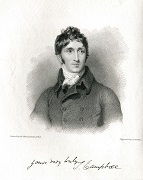 |
| P3008 | Portraits | | The Miad of Saragosa, 1832. Drawn by Painted by FStone and engraved by W Finden for the "Life and Works of Lord Byron". Steel engraving. Agustina Raimunda Mar?a Saragossa Dom?nech, or Agustina of Arag?n (1786-1857) was a Spanish heroine who defended Spain during the Spanish War of Independence, first as a civilian and later as a professional officer in the Spanish Army. Known as ?the Spanish Joan of Arc?, she was the subject of folklore and art, including sketches by Goya and the poetry of Lord Byron. | h 90mm x w 105mm | £10 | 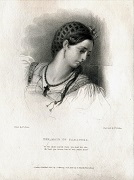 |
| P2960 | Portraits | | The Revd W Jones, c1846. Steel engraving. William Jones (1726-1800), known as William Jones of Nayland, was a clergyman and author. Educated at Charterhouse School and University College, Oxford, he became friends with George Horne (later bishop of Norwich) becoming his chaplain, afterwards writing his life. His vicarage was the centre of a High Church coterie, and he was a link between the non-jurors and the Oxford Movement. | h 142mm x w 112mm | £8 | 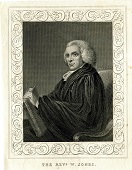 |
| P3011 | Portraits | | The Right Hobnble. Anne Isabella, Lady Noel Byron, 1832. Painted by W J Newton and engraved by W H Mote for the "Life and Works of Lord Byron". Steel engraving. Anne Isabella Noel Byron, 11th Baroness Wentworth and Baroness Byron (1792-1860) was the wife of poet George Gordon Byron, (Lord Byron). Her daughter, Ada Lovelace, worked as a mathematician with Charles Babbage, precursor of computer science | h 120mm x w 98mm | £8 | 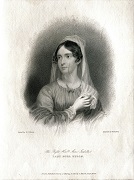 |
| P2927 | Portraits | | The Right Honourable Anne-Isabella, Lady Noel Byron, c1850. Drawn by W J Newton and engraved by W H Mote. Steel engraving. Anne Isabella Noel Byron, 11th Baroness Wentworth and Baroness Byron (1792?1860) was the wife of poet George Gordon Byron, (Lord Byron). Her daughter, Ada Lovelace, worked as a mathematician with Charles Babbage, precursor of computer science. | h 97mm x w 103mm | £10 | 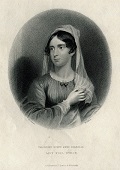 |
| P2916 | Portraits | | The Rt Hon Lady Caroline Lamb, c1850. Engraved by W Finden and published by A Fullarton. Stripple engraving. Lady Caroline Lamb (1785?1828) was a British aristocrat and novelist, best known for her affair with Lord Byron. Her husband, William Lamb, 2nd Viscount Melbourne, later became Prime Minister. | h 113mm x w 97mm | £8 | 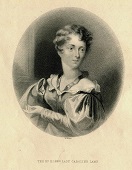 |
| P2994 | Portraits | | The Rt Honourable Sarah Sophia Jane, Countess of Jersey, 1833. Painted by E T Parris and engraved by H T Ryall for the "Life and Works of Lord Byron". Steel engraving. Sarah Sophia Child Villiers (1785-1867) was the daughter of the 10th Earl of Westmorland. She inherited Osterley Park and became senior partner of the bank Child & Co. In 1804 she married George Child Villiers, 5th Earl of Jersey. She was a patronesses of Almack's, the most exclusive social club in London, and a leader of the ton during the Regency. She was made famous as Zenobia in Disraeli's novel Endymion. Caroline Lamb ridiculed her in Glenarvon. | h 130mm x w 117mm | £8 | 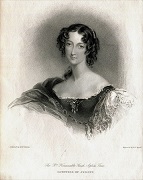 |
| P2911 | Portraits | | The late Empress Maria Louisa. Published in 1816 by John Bell. Stipple engraving. | h 143mm x w 115mm | £10 | 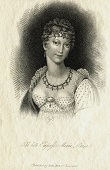 |
| P2925 | Portraits | | The picture of the most noble and learned lady Arabella Steuart, 1799. Published in Richardson's "Portraits illustrating Granger's Biographical History of England,". Copper engraving. Lady Arbella Stuart (or Arabella Stewart) (1575?1615) was considered a successor to Elizabeth I. She was a great-great-granddaughter of Henry VII and in line to the English throne. She died a prisoner in the Tower of London. | h 137mm x w 108mm | £18 | 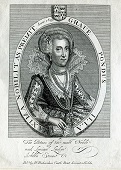 |
| P2965 | Portraits | | Thomas Cranme, Archbishop of Canterbury. From an Original Pictiure in the Picture Gallery, Oxford, 1792. Drawn by S Harding and engraved by R Clamp. Copper engraving. Henry VIII (1491-1547) was King of England from 1509 until his death. He was Lord, and later assumed the Kingship, of Ireland, and continued the claim by English monarchs to the Kingdom of France. Besides his six marriages, he is known for his establishment of the Church of England and the Dissolution of the Monasteries. | h 109mm x w 93mm | £10 | 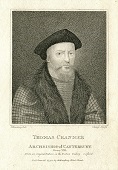 |
| P2968 | Portraits | | Thomas Cranmer, Archbishop of Canterbury. From the original of "Gerbicus Flicciis" in the British Museum, c1850. Published by the London Printing & Publishing Company. Steel engraving. Thomas Cranmer (1489-1556) was a leader of the English Reformation and Archbishop of Canterbury during the reigns of Henry VIII, Edward VI and Mary I | h 193mm x w 161mm | £10 | 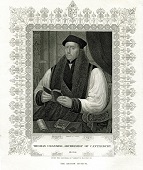 |
| P2966 | Portraits | | Thomas Moore, 1831. Painted by F Sicurec and engraved by G Adcock. Published by Fisher Son & Co. Steel engraving. Thomas Moore (1779-1852) was an Irish poet, singer, songwriter, and entertainer, best remembered for the lyrics of "The Minstrel Boy" and "The Last Rose of Summer". He was responsible, with John Murray, for burning Lord Byron's memoirs after his death. He was often referred to as Anacreon. | h 114mm x w 88mm | SOLD | 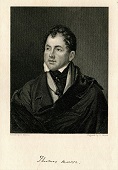 |
| P2952 | Portraits | | Thomas Wolsey, c1780 . Engraved by Adam. Copper engravin. Trimmed toborder on righthand side . Not affecting image. | h 128mm x w 118mm | £8 | 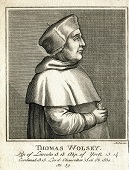 |
| P2933 | Portraits | | Wellington, 1836. Painted by Sir Thomas Lawrence and engraved by H Robinson. Published by Fisher, Son & Co. Steel engraving. Field Marshal Arthur Wellesley, 1st Duke of Wellington (1769-1852), was one of the leading military and political figures of 19th-century Britain, famous for his defeat of Napoleon at the Battle of Waterloo in 1815. After his active military career, Wellesley returned to politics and was twice prime minister as part of the Tory party. | h 129mm x w 101mm | SOLD | 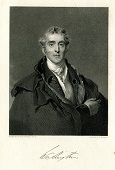 |
| P2964 | Portraits | | Wolsey, c1757. Engraved by Benoist for Smollett's "History of England". Copper engraving. Thomas Wolsey (1473-1530) was an English political figure and a cardinal of the Roman Catholic Church. By 1514 he was the controlling figure in most matters of state and extremely powerful within the Church. The highest political position he attained was Lord Chancellor. When he fell out of favour he retreated to York to fulfil his church duties as Archbishop of York. He was recalled to London to answer to charges of treason but died en route of natural causes. | h 87mm x w 76mm | £5 | 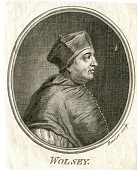 |
| P2844 | Portraits | Chester | The Effiges of ye Right Honourable Charles Earle of Carlisle, Viscount Morpeth, Baron Dacres of Gillsland, Lord Leiutenant of Cumberland & Westmoreland, Vice Admirall of ye Countyes of Northumberland, Cumberland, Westmoreland, ye Bishoprick of Durham, The Town & County of Newcastle & Maritin parts there adicent & one of his Mjestyes most Honourabl privy Councell. 1669. Engraved by Abraham Blotling. Copper engraving. | h 257mm x w 171mm | £25 | 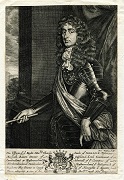 |